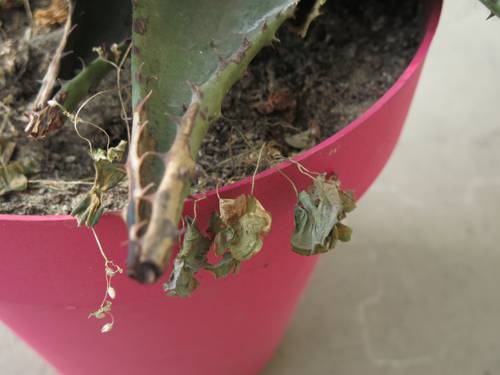
FAQ About Indoor Plant Gravity Irrigation Techniques

What is gravity-based irrigation for indoor plants?
Gravity-based irrigation is a technique that utilizes the natural force of gravity to deliver water to indoor plants. This method involves setting up a water reservoir at a higher elevation than the plants, allowing the water to flow downwards through tubing or wicks without using any pumps or electricity. It's an efficient way to provide consistent moisture with minimal effort and resources.

How does gravity-based irrigation work for indoor plants?
Gravity-based irrigation systems rely on a simple setup where water is placed in an elevated container, such as a tank or reservoir. From there, water travels down through tubes or wicks to the base of each plant pot. This method ensures that plants receive water through capillary action or drip, depending on the system design. The flow can be controlled by using valves or adjusting the height of the reservoir to meet the specific needs of different plants.

What are the benefits of using gravity-based irrigation for indoor plants?
Gravity-based irrigation offers several advantages. Firstly, it conserves water by providing just the right amount of moisture directly to the plant roots. Secondly, it requires no electricity, making it environmentally friendly and cost-effective. Additionally, it can be easily adjusted to suit different plant species and is an excellent solution for individuals looking to automate plant care with minimal technological intervention.

What materials are needed for setting up a gravity irrigation system indoors?
To set up a gravity irrigation system for indoor plants, you'll need a water reservoir or container that can be elevated above plant pots, flexible tubing or wicks, and potentially valves or drippers for controlling water flow. You might also need additional supports or stands to hold the water reservoir at a higher level. These materials are generally inexpensive and readily available at gardening or hardware stores.

Can gravity irrigation systems be used for all types of indoor plants?
While gravity irrigation systems are versatile, they may not be suitable for all types of indoor plants. Plants with very specific water requirements or those susceptible to overwatering might not benefit from this system. It's important to assess the needs of each plant and configure the system accordingly. Generally, houseplants with moderate water needs, such as ferns or peace lilies, adapt well to gravity-based irrigation.

How do you control the water flow in a gravity-based irrigation system?
Controlling water flow in a gravity-based irrigation system can be achieved by adjusting the height of the water reservoir, using valves, or incorporating drippers into the tubing. Higher tanks increase water pressure, which can be lessened by lowering the reservoir or adding a valve to moderate the flow. This adaptability allows gardeners to tailor the system to meet specific plant moisture requirements.

What are some common challenges with gravity irrigation for indoor plants?
Some common challenges include maintaining consistent water pressure and flow, especially if the elevation difference is minimal. Blocked or clogged tubing can also disrupt water delivery. Additionally, finding the right balance to prevent over or under-watering can be tricky for some plant types. Regular maintenance and monitoring can help overcome these challenges.

How often should the water reservoir be refilled in a gravity irrigation system?
The frequency of refilling the water reservoir in a gravity irrigation system depends on the size of the reservoir, the number of plants, and the specific water needs of those plants. Typically, a larger reservoir can maintain a steady water supply for about a week. It's crucial to monitor water levels regularly, especially during dry or hot weather conditions, to ensure plants receive adequate hydration.

Is gravity irrigation suitable for beginners in indoor gardening?
Gravity irrigation can be an excellent option for beginners due to its simplicity and low maintenance requirements. It eliminates the need for daily hand watering and allows novice gardeners to learn about plant hydration needs over time. Additionally, it provides a reliable and automatic way to keep plants watered, reducing the likelihood of common watering mistakes made by beginners.

How do you ensure plants are not overwatered using gravity irrigation?
To avoid overwatering, it's important to use a well-designed system that provides slow and controlled water delivery, possibly by incorporating drippers or adjusting the height of the reservoir appropriately. Selecting suitable plant pots with proper drainage holes and using a well-draining potting mix can further prevent excessive water retention. Monitoring soil moisture and adjusting the water flow based on observed plant needs can also help.

Can gravity irrigation systems be used with liquid fertilizers?
Yes, gravity irrigation systems can be used with liquid fertilizers by adding diluted fertilizer solution directly to the water reservoir. This allows nutrients to be evenly distributed to all plants with minimal effort. However, it is important to ensure that the fertilizer concentration is appropriate for the plants' needs and not to over-fertilize, as this can harm the plants.

What is a simple DIY method for setting up a gravity irrigation system at home?
A basic DIY gravity irrigation setup could involve a large water bottle or jug placed on a shelf or stand above the plant pots. Drill holes into the cap for inserting tubing or wicks that lead into the soil of each pot. Ensure the setup allows for controlled water flow and adjust as necessary. This setup is simple, cost-effective, and can be customized as needed to suit different plant arrangements.

How do you troubleshoot common issues in gravity-based irrigation systems?
Common issues include leaks, clogs, and uneven water distribution. For leaks, ensure all connections are tight and tubing is intact. Address clogs by flushing the system with water and periodically cleaning the tubes. If water distribution is uneven, check the height and angle of the reservoir and adjust the tubing or reservoir placement as needed to ensure a consistent flow to all plants.

Are there commercial gravity-based irrigation systems available for purchase?
Yes, there are commercially available gravity-based irrigation systems designed specifically for indoor use. These systems often come with all necessary components, such as reservoirs, tubing, and drippers, providing an easy-to-assemble solution. They are available in different sizes and configurations to accommodate various indoor gardening setups and are designed to help optimize water use efficiency.

How can gravity irrigation help in sustainable indoor gardening?
Gravity irrigation contributes to sustainable gardening by minimizing water wastage and reducing reliance on electricity or artificial irrigation systems. By naturally regulating water distribution, it ensures plants receive adequate hydration without excess. Furthermore, it supports sustainable practices by encouraging responsible water usage and can be paired with rainwater collection systems for an even more eco-friendly approach.

What type of tubing is best for a gravity irrigation system?
The best tubing for a gravity irrigation system is flexible, durable, and sized appropriately to facilitate smooth water flow. Many gardeners opt for PVC or silicone tubing, which are resistant to clogging and can efficiently handle varying water pressures. The tubing's diameter should be sufficient to allow the desired flow rate to the plants without causing backups or leaks.

Can gravity irrigation systems be combined with other irrigation methods?
Yes, gravity irrigation systems can be integrated with other methods, such as drip irrigation, for added efficiency. By combining systems, gardeners can tailor water delivery to meet unique plant needs, optimize usage during varying seasonal conditions, and incorporate advanced features like timers or moisture sensors to further automate and customize their watering strategy.

Is maintenance required for gravity irrigation systems?
Regular maintenance, including checking for leaks, cleaning the tubing to prevent blockages, and monitoring water levels, ensures the efficient operation of gravity irrigation systems. It's advisable to occasionally inspect system components for wear and tear, especially fittings and seals, to avoid disruptions. Routine maintenance helps prolong the system's life and maintains consistent watering performance.

How do weather conditions affect indoor gravity irrigation systems?
While indoor plants are typically less affected by weather changes due to being in a controlled environment, factors like household heating can impact evaporation rates and plant water needs. In warmer, drier conditions, plants may require more frequent watering, necessitating closer monitoring of water levels in the reservoir. Adjustments may be required to ensure the system continues to meet the plants' needs effectively.

Can gravity irrigation systems be used for small-scale indoor farms?
Gravity irrigation systems are well-suited for small-scale indoor farms as they offer scalable solutions for efficient water management. With proper design and setup, these systems can cater to various plant species and layouts, making them ideal for hydroponic setups or vertical gardening applications. They provide a low-cost, low-energy solution tailored to the sustainable production of herbs, vegetables, and ornamental plants indoors.
